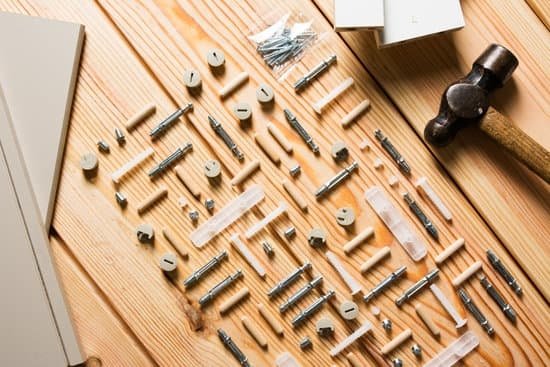What is spline construction in woodworking? Spline construction is a technique used in woodworking to join two pieces of material together, typically at a 90-degree angle. This method involves creating a slot or groove in the joint and inserting a thin strip of wood, also known as a spline, to strengthen and reinforce the connection. In this article, we will explore the history, purpose, benefits, tools, techniques, and creative applications of spline construction in woodworking.
Spline construction has been utilized for centuries as a reliable and durable method for joining wood pieces together. The practice has evolved over time with advancements in tools and materials, making it an essential skill for woodworkers of all levels.
Understanding the purpose and benefits of spline construction is crucial for any woodworker looking to enhance their joinery skills. From providing additional strength and stability to offering design versatility and aesthetic appeal, spline construction has numerous advantages that will be discussed further in this article.
In addition to learning about the process and advantages of spline construction, we will also explore the tools and materials needed to execute this technique effectively. Whether you are a beginner or an experienced woodworker, mastering spline construction can open up new possibilities for your woodworking projects. So let’s delve into the world of spline construction and discover how it can elevate your craftsmanship.
History and Origins of Spline Construction in Woodworking
Spline construction in woodworking has been around for centuries, with its origins dating back to ancient civilizations. The concept of using a thin strip of wood to reinforce joints and add decorative elements to furniture and other wooden items can be traced back to early Egyptian and Chinese craftsmanship. These early artisans discovered that adding splines to their wooden creations not only improved the structural integrity but also enhanced the overall aesthetic appeal.
One of the earliest documented uses of spline construction is found in the furniture of ancient Egypt, where intricate and ornate designs were achieved by incorporating meticulously crafted splines into wooden pieces. This technique eventually spread to other parts of the world, evolving over time as different cultures developed their unique methods and styles for spline construction.
In modern woodworking, spline construction continues to be a popular method for strengthening joints and adding visual interest to projects. While technological advancements have led to the development of new tools and techniques, the basic principles behind spline construction remain unchanged. Woodworkers today still rely on this age-old method to create durable and visually appealing furniture, cabinetry, and decorative items.
The Purpose and Benefits of Spline Construction
Spline construction in woodworking is a technique used to strengthen and reinforce joints in woodwork projects. The purpose of using spline construction is to create durable and long-lasting connections between pieces of wood, especially in instances where traditional methods such as glue or nails may not be sufficient. By inserting a thin strip of wood (the spline) into a slot or groove cut into the joint, woodworkers can significantly increase the strength and stability of their creations.
One of the primary benefits of spline construction is its ability to add strength and support to corners and edges, particularly in items like picture frames, cabinets, tabletops, and boxes. Additionally, spline construction can also be used to align pieces during assembly, ensuring the accuracy and precision of the final product. This technique allows for a more seamless appearance by hiding end grain and creating a visually appealing design element.
In addition to providing structural integrity and an aesthetic touch, spline construction also offers versatility in terms of design possibilities. Woodworkers have the flexibility to choose different types of splines and incorporate them into various joint configurations, allowing for creativity and customization in their projects. Whether it’s contrasting wood colors or unique patterns created by different spline placements, this method adds a decorative aspect to woodworking projects while serving a practical purpose.
| Purpose | Benefits |
|---|---|
| Strengthens joints | Enhances durability |
| Provides support to edges/corners | Allows for precise alignment |
| Offers design versatility | Adds decorative element |
Tools and Materials Needed for Spline Construction
When it comes to spline construction in woodworking, there are several tools and materials that are essential for successfully creating strong and durable joints. The primary tool needed for spline construction is a table saw, which is used to cut the slots or grooves into the wood where the splines will be inserted. Additionally, a router with a straight bit can also be used for this purpose, especially when working with smaller pieces of wood.
In terms of materials, the key component needed for spline construction is the spline itself. Splines can be made from a variety of materials such as hardwood, softwood, or even metal, depending on the specific requirements of the woodworking project. It’s important to select a material that is compatible with the type of wood being used and that will provide sufficient strength and support for the joint.
Other essential tools and materials for spline construction include clamps to hold the pieces of wood together during the cutting and gluing process, as well as glue to secure the splines in place within the slots or grooves. Additionally, having precise measuring tools such as a ruler and marking gauge is crucial for ensuring accuracy and consistency throughout the spline construction process.
Overall, having access to high-quality tools and materials is essential for achieving successful spline construction in woodworking projects. By utilizing these resources effectively, woodworkers can create strong and visually appealing joints that contribute to the overall durability and aesthetics of their creations.
Step-by-Step Guide to Spline Construction Process
When it comes to woodworking, spline construction is a technique that can add both strength and visual interest to your projects. This process involves inserting a thin strip of wood (known as a spline) into a slot that has been cut into two adjoining pieces of wood. The result is a strong joint that can also add decorative flair to your woodworking projects.
Preparation and Planning
Before beginning the spline construction process, it’s important to carefully plan out your project and determine where splines will be necessary or beneficial. Once you’ve identified these areas, you’ll need to gather the necessary tools and materials, including a table saw, router, spline jig, glue, and clamps.
Cutting the Slots
The first step in the actual construction process is cutting the slots for the splines. This is typically done using a table saw or router with a straight bit. It’s important to carefully measure and mark the location for each slot before making any cuts. Once the slots have been cut, it’s a good idea to do a test fit with some scrap pieces of wood and splines to ensure everything fits properly.
Gluing and Clamping
After cutting the slots, the next step in the process is gluing the splines into place. Apply glue to both sides of each spline before gently tapping them into their respective slots. Once all of the splines are in place, use clamps to hold everything together while the glue dries. After allowing sufficient drying time, trim off any excess spline material and sand down any rough edges for a smooth finish.
By following these steps and paying close attention to detail, you can achieve strong, visually appealing joints in your woodworking projects using spline construction techniques.
Different Types of Joints Utilized in Spline Construction
Biscuit Joints
One of the most common types of joints utilized in spline construction is the biscuit joint. This type of joint involves using small, flattened, and elongated wooden oval-shaped pieces known as biscuits to join two pieces of wood together. Biscuit joints are popular in spline construction due to their ability to provide additional strength and stability to the joint.
Dovetail Joints
Dovetail joints are another type of joint frequently used in spline construction. These joints are known for their interlocking design, which adds significant strength to the joint. Dovetail joints are favored in woodworking for their durability and resistance to being pulled apart, making them a reliable choice for spline construction projects.
Mitered Joints
Mitered joints are commonly employed in spline construction due to their clean and seamless appearance. These joints involve cutting two pieces of wood at an angle, usually 45 degrees, and joining them together to form a corner. While mitered joints may not be as strong as other types of joints, they are often reinforced with splines to enhance their structural integrity.
In using these various types of joints in spline construction, woodworkers can create strong, durable, and visually appealing connections between wood pieces. Understanding the characteristics and benefits of each type of joint is essential for achieving successful results in spline construction projects.
Common Mistakes to Avoid in Spline Construction
Spline construction in woodworking can result in beautiful, durable joints, but there are some common mistakes that should be avoided to ensure a successful project. Here are some of the most frequent errors and how to prevent them:
1. Incorrect Cutting: One of the most common mistakes in spline construction is cutting the grooves or slots improperly. This can lead to ill-fitting splines or weak joints. To prevent this, it is essential to use precise measurements and the appropriate cutting tools such as a table saw or router. Ensure that the grooves are straight and accurately sized to fit the splines snugly.
2. Poor Glue Application: Another mistake that often occurs in spline construction is improper application of glue. It’s crucial to evenly spread a thin layer of glue on both the spline and inside the slots before inserting the spline into place. Excess glue should be wiped away immediately to avoid messy joints and weakened adhesion.
3. Neglecting Wood Preparation: Neglecting proper wood preparation before creating spline joints can result in weak or uneven joints. It’s important to ensure that the wood surfaces are flat, smooth, and clean before beginning the construction process. Failing to do so may cause misaligned or loose splines.
By being mindful of these common mistakes and taking steps to avoid them, woodworkers can achieve strong and visually appealing spline joints in their projects.
Creative Ways to Incorporate Spline Construction in Woodworking Projects
Spline construction in woodworking is a versatile technique that can be incorporated into various types of woodworking projects. By using splines, woodworkers can add strength, visual interest, and unique design elements to their creations. Here are some creative ways to incorporate spline construction in woodworking projects:
- Decorative Inlays: One interesting way to use spline construction is by incorporating decorative inlays into your woodworking projects. By creating grooves or channels and inserting contrasting wood or even different materials like metal or acrylic, you can add a pop of color and texture to your pieces.
- Hidden Joinery: Spline construction can also be used to create hidden joinery in woodworking projects. By incorporating splines into the joint areas of furniture pieces or other wooden items, you can create strong bonds while maintaining a seamless and clean appearance.
- Strength and Stability: Another creative way to utilize spline construction is by emphasizing the strength and stability it adds to the overall structure of a woodworking project. By strategically placing splines in key stress points, such as table legs or drawer corners, you can ensure that your piece will withstand the test of time.
Incorporating spline construction into your woodworking projects not only adds structural integrity but also opens up a world of design possibilities. Whether you choose to use splines for decorative purposes, hidden joinery, or added strength, this technique allows woodworkers to elevate their creations to new levels of craftsmanship.
By experimenting with different types of joints and materials for spline construction, woodworkers can achieve unique and custom looks for their projects while ensuring durability and longevity. With careful planning and execution, spline construction can become an essential tool in expanding the creative potential of any woodworking enthusiast’s repertoire.
Conclusion
In conclusion, the use of spline construction in woodworking offers numerous advantages that make it a valuable technique for woodworkers. By reinforcing joints and providing added strength and stability to projects, spline construction ensures that furniture and other woodworking creations will withstand the test of time.
One of the key benefits of spline construction is its ability to add decorative flair to woodworking projects. Through creative design choices, woodworkers can incorporate splines in unique and visually appealing ways, adding an extra level of artistry to their work. Additionally, splines can be made from contrasting wood species, creating striking visual accents within the project.
Furthermore, the versatility of spline construction allows for endless possibilities in woodworking. Whether creating picture frames, tabletops, or cabinets, the use of splines provides an opportunity for woodworkers to explore new design elements and push the boundaries of their craft. Overall, incorporating spline construction into woodworking projects not only enhances the durability and strength but also elevates the aesthetic appeal of finished pieces.
Frequently Asked Questions
What Is a Spline Joint?
A spline joint is a method of joining two pieces of material, typically wood or metal, by interlocking a series of ridges and grooves. This creates a strong and flexible connection between the two pieces.
What Is a Spline in Construction?
In construction, a spline is a thin strip of material, often wood or metal, that is used to connect two larger pieces together along their edges. It provides structural support and helps to align the pieces during assembly.
What Are the Advantages of a Spline Joint?
The advantages of a spline joint include its ability to distribute stress evenly across the connected pieces, resulting in a stronger overall structure. Splines also provide flexibility and allow for some movement while still maintaining their strength, making them ideal for applications where there may be some shifting or vibration.
Additionally, splines can help to ensure precise alignment between the joined pieces, leading to a more accurate and polished final product.

Hi everyone! I’m a woodworker and blogger, and this is my woodworking blog. In my blog, I share tips and tricks for woodworkers of all skill levels, as well as project ideas that you can try yourself.





